How to Choose the Best Knee Brace for Arthritis
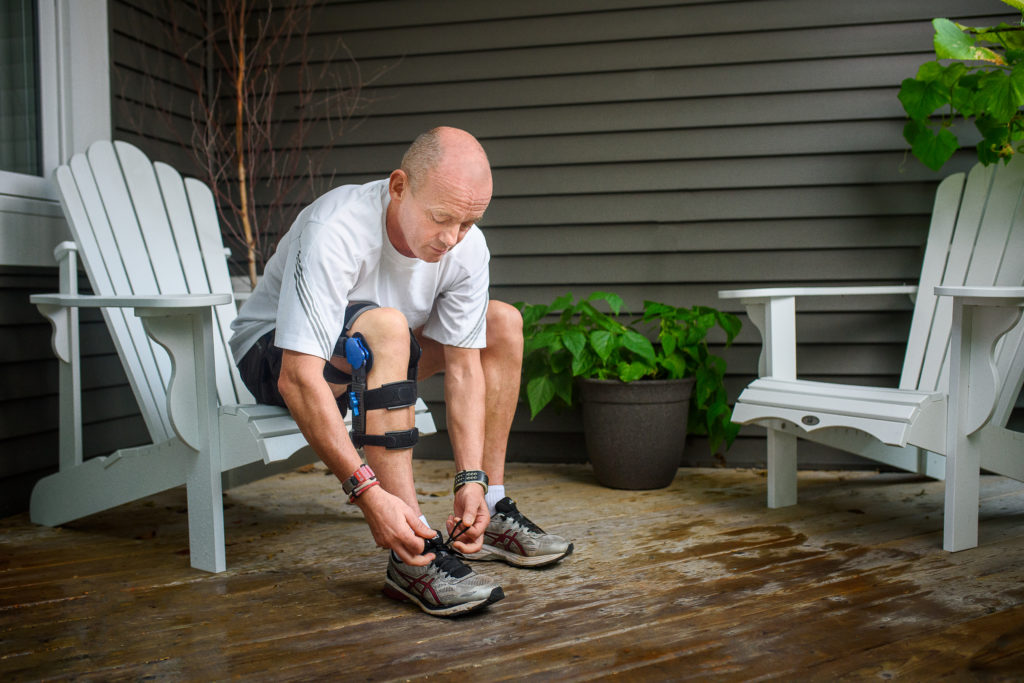
Knee bracing solutions are increasing in popularity, particularly with the advent of tri-compartment offloading technology. This recent advancement in knee bracing technology now provides all knee osteoarthritis patients the opportunity to relieve their knee pain. There are more product choices than ever before and as a consequence, more diligence is required to ensure you select the product that best fits your situation. Choosing the wrong knee brace for arthritis can lead to frustration and disappointment as it will provide only a slight benefit. Choosing the right brace could afford you with life-changing increases in mobility, reduced pain, and confidence. What brace is right for you? It all depends on the pattern of knee arthritis you have.
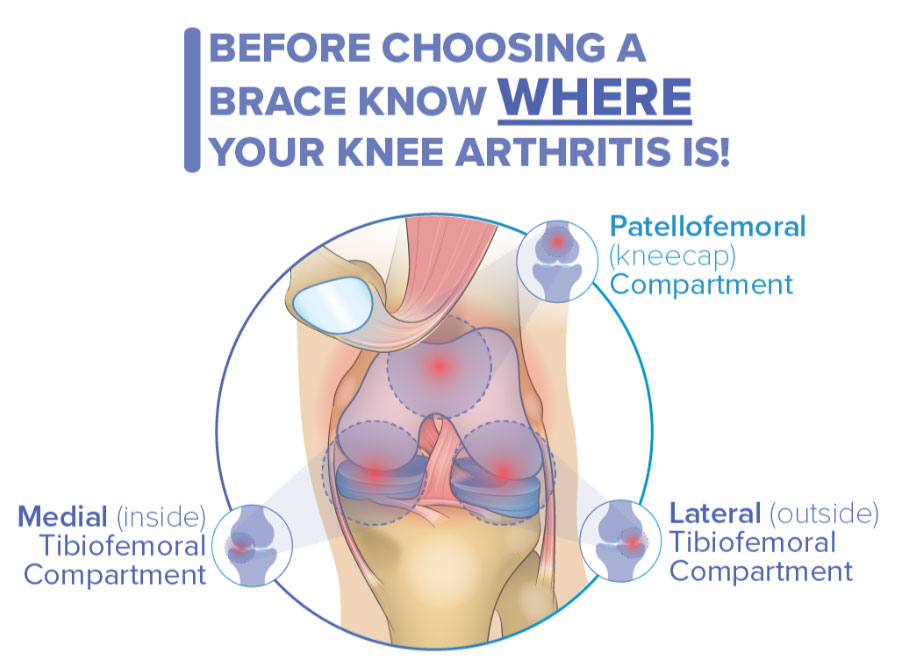
Knee Braces for Arthritis – Location Location Location!
Your doctor may have told you that you have knee arthritis, but that’s only half the story. Arthritis attacks your knees in a variety of different patterns. Your knee has three distinct areas that are under immense pressure during joint movement. In medical jargon, these pressurized contact zones of the joint are known as compartments (Figure 1). Compartments are where load transfer occurs between bones. Bone in these areas is coated with articular cartilage that provides lubrication — reducing friction during movement. There are three compartments within the knee joint: (1) patellofemoral compartment, (2) inside tibiofemoral compartment and (3) outside tibiofemoral compartment. Knowing the affected compartment(s) will help to determine what type of knee brace for arthritis will work for you.
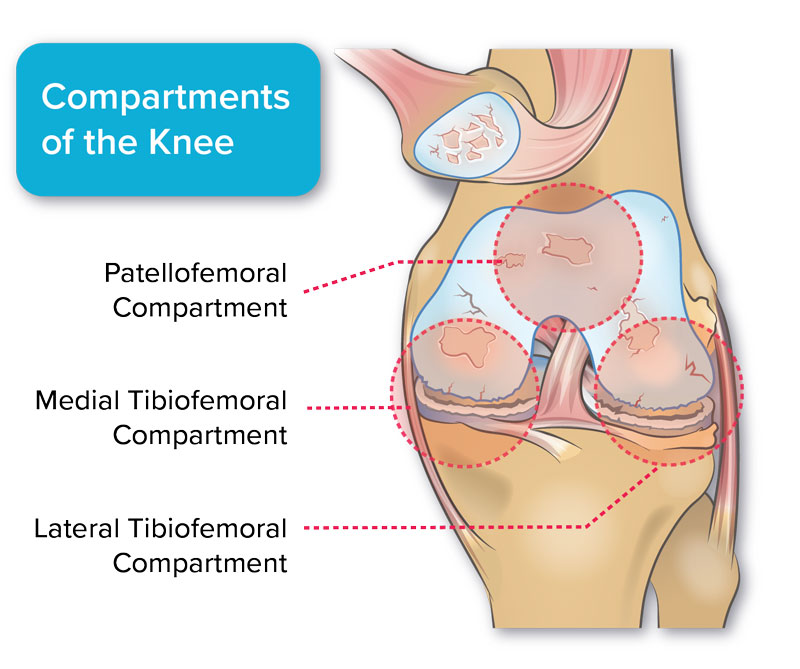
How do Knee Arthritis Braces Work?
Most general-purpose rigid frame knee braces are limited in their ability to relieve arthritis symptoms. These braces provide increased lateral stability which may improve balance. While this can help, it does not address the root problem causing the pain in arthritic knees. Bone on bone pressure and increased friction due to cartilage loss are the primary factors leading to arthritis joint pain. Knee braces designed specifically to treat arthritis reduce pressure in areas of the knee joint most affected by the disease. In doing so, the bone on bone pressure and friction is decreased. This allows users to move more easily with less pain. These arthritis knee braces are called “offloader knee braces” because they actively offload pressure within the joint (Figure 2).
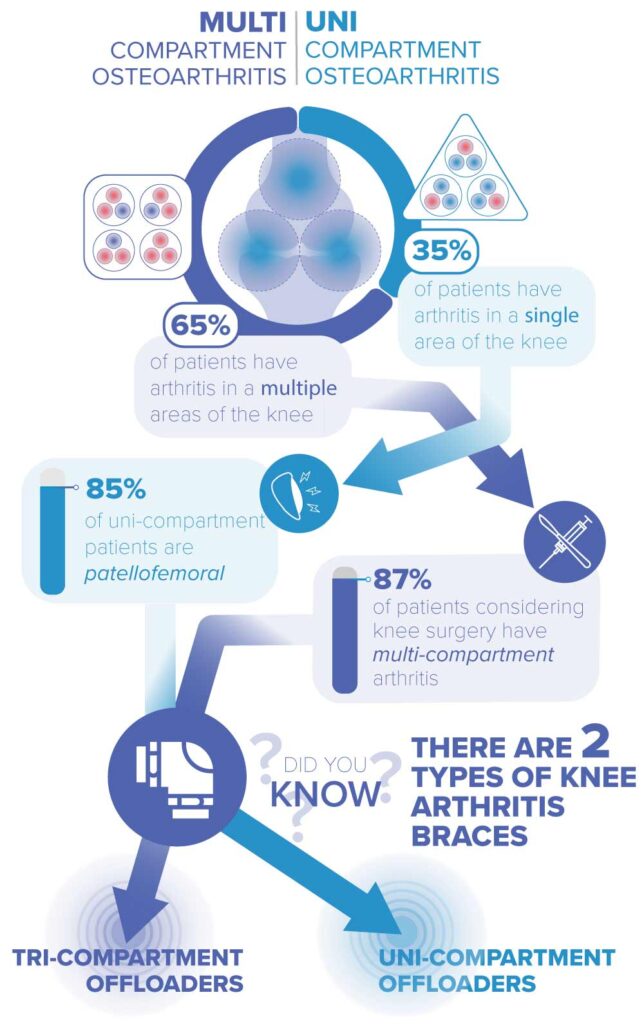
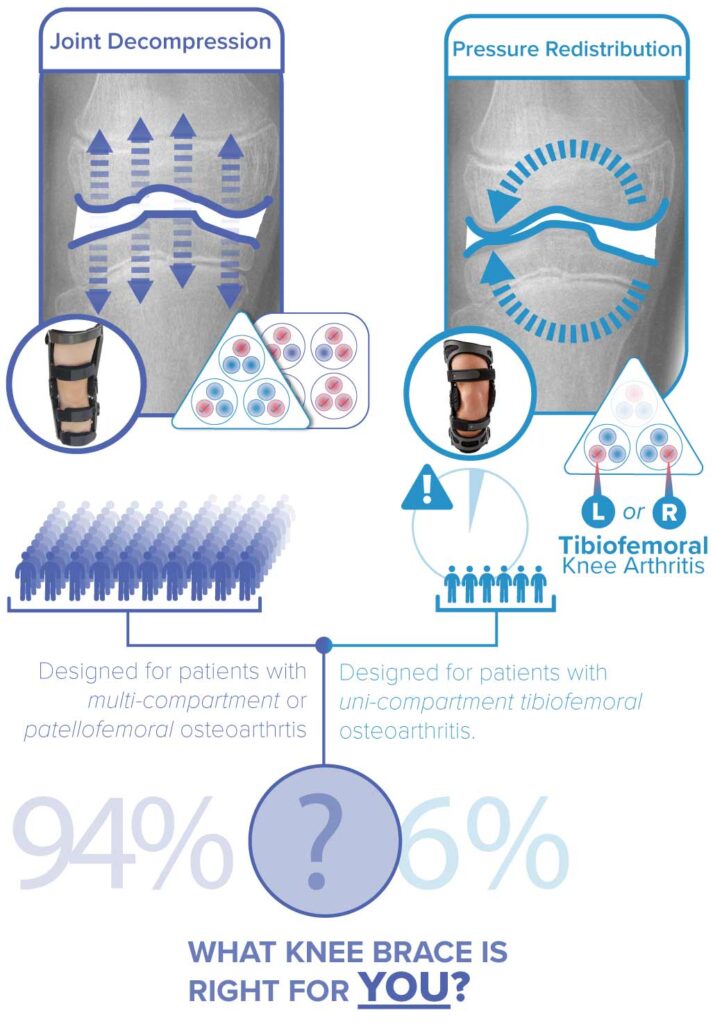
Types of Knee Arthritis
There are two main categories of knee arthritis: multi-compartment and uni-compartment. “Multi-compartment” implies that you have arthritis in more than one compartment while “uni-compartment” suggests that only a single area of the knee joint is affected. There are two subtypes of uni-compartment osteoarthritis that are important to distinguish between: patellofemoral and tibiofemoral. Patellofemoral knee arthritis indicates that the cartilage behind your knee cap has been damaged. Tibiofemoral arthritis – which can occur on the right or left side of the joint – refers to the cartilage between the top of your shin bone (tibia) and the bottom of your thigh bone (femur).
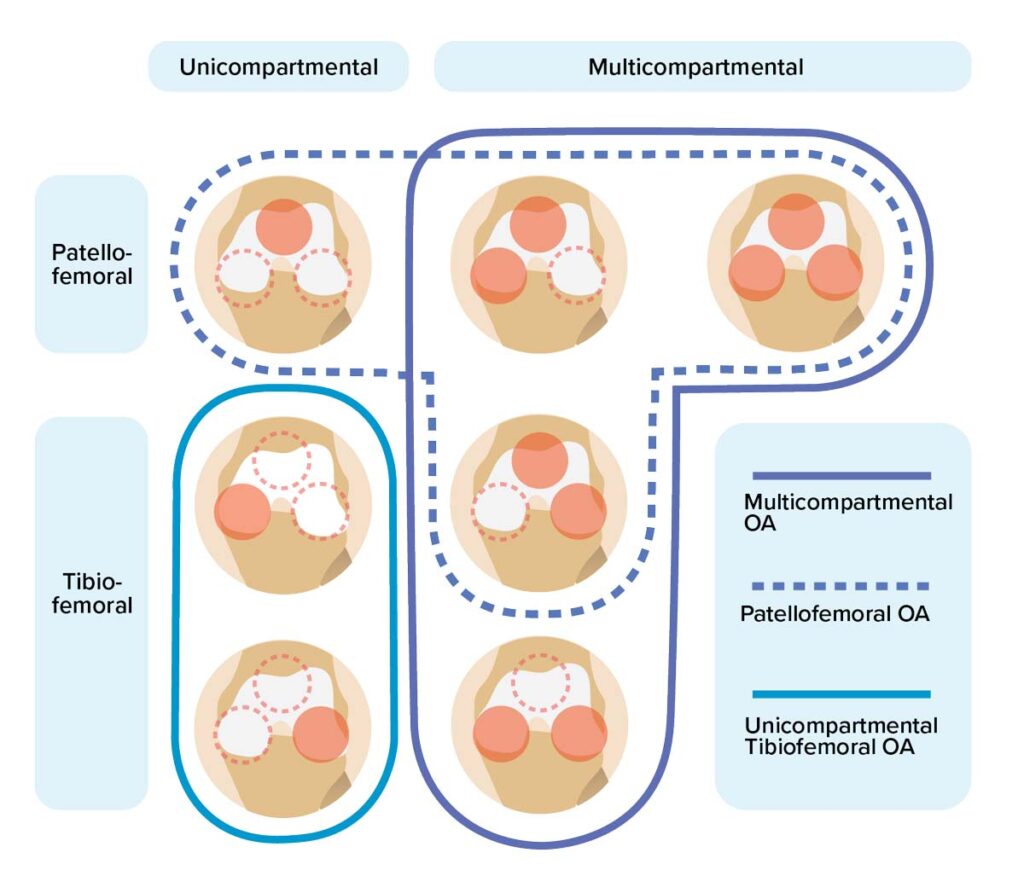
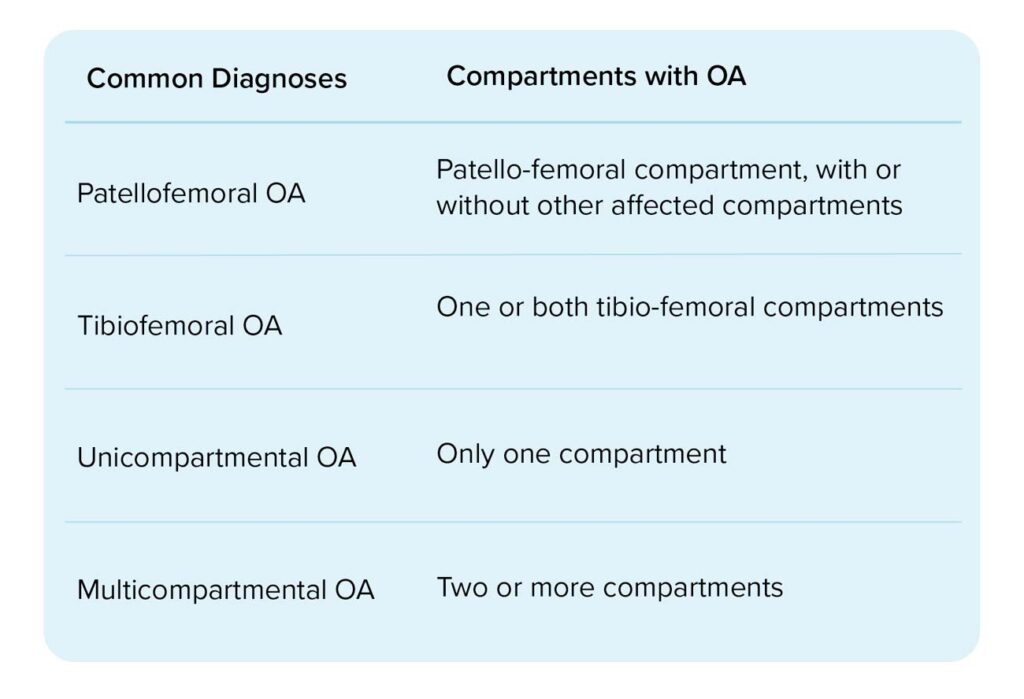
What Type of Knee Arthritis Do I have?
Your doctor can help you definitively determine which pattern of knee arthritis you have. This is done via diagnostic imaging such as an X-ray or MRI. Using this information, specialists can determine which compartments have bone spurs developing and where bone on bone pressure is occurring.
The location of your knee pain and the activities that aggravate your symptoms can offer clues as to the pattern of knee arthritis that you have (see table below)15. Remember, a series of properly taken radiographs looking at your knee from different angles is the only definitive way to know what pattern of knee OA you have. Be sure to consult your doctor to determine the final diagnosis.
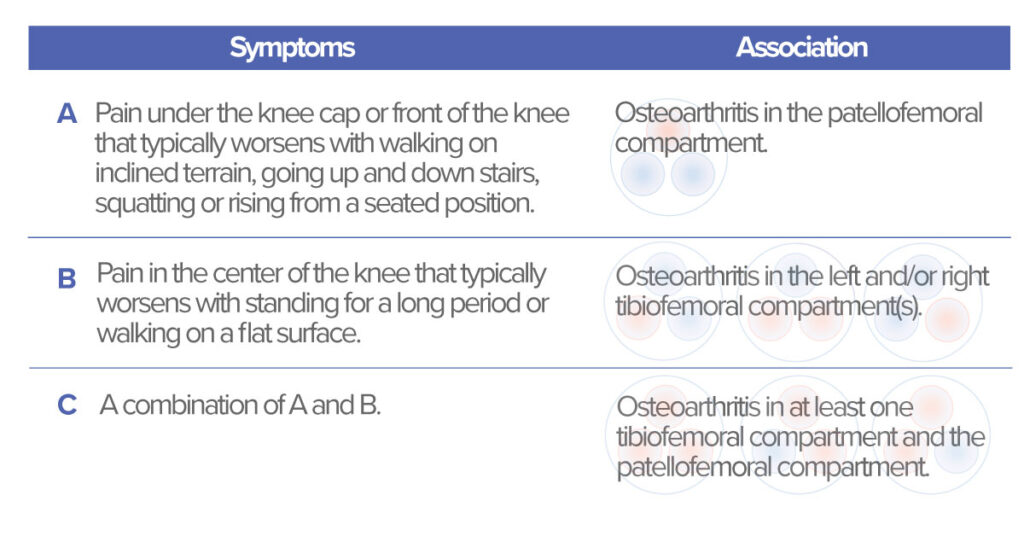

Some variations of knee osteoarthritis are more common than others. Multi-compartment knee arthritis represents close to 65% of total cases5-11 (Figure 3). Of these, 90%10 of cases involve the patellofemoral compartment. Multi-compartment arthritis is even more common in those suffering from severe knee arthritis (87%)12. Of those with uni-compartment arthritis, the patellofemoral joint is the most commonly affected structure7-11.
Knee Braces for Arthritis – What do I Choose?
There are two types of offloader knee braces for arthritis. Uni-compartment offloader braces often use tension strapping systems to pull the knee joint more to one side or the other. This allows pressure to be reduced in either the left tibiofemoral or right tibiofemoral compartment. By shifting pressure from the arthritic compartment to healthy compartment pain is reduced. Braces using this offloading mechanism can provide significant benefits for those with isolated medial or lateral tibiofemoral osteoarthritis. Approximately 3-20%10,13 of osteoarthritis patients have this particular pattern of degeneration (one study suggests that it could be as few as 6% of patients7).
Tri-compartment offloader knee braces use a spring hinge system to decompress the knee joint as it bends. In doing so, joint contact forces are simultaneously reduced in all three compartments by over 40%14. This is analogous to the therapeutic effect of dramatic weight loss on knee pain and function. Tri-compartment offloader knee braces for arthritis alleviate pain by reducing pressure across the entire joint in the same way losing 45 lbs of bodyweight would decrease joint stress17. This is the only type of knee brace designed specifically to help with multi-compartment and isolated patellofemoral knee arthritis. Over half of patients have one of these patterns of knee arthritis, with one study reporting over 90% of patients showing these patterns of damage7, 18-20.
Wearing a tri-compartment offloader is associated with noticeable reductions in pain and pressure, as well as increases in mobility. Among Spring Loaded customers with knee osteoarthritis, 95% reported they experienced reduced pain and 85% reported they experienced increased mobility.16
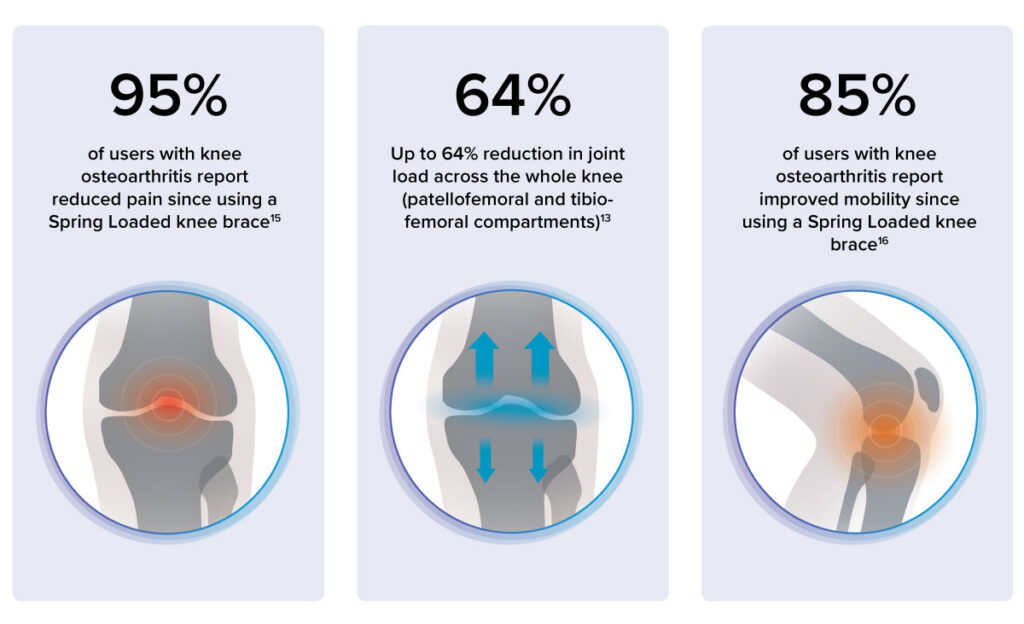
If you’re still unsure which type of brace is right for you, take a look at our in-depth comparison of a popular Donjoy knee brace with Levitation here. The article will also help you understand how Levitation compares to traditional offloader braces.
And if you want to learn more about what makes Levitation special, watch the video below. The animation illustrates how liquid spring hinge technology can help you do more of what you love.
Let Us Help You! Call 1.877.209.8780 to Speak to a Bracing Specialist
What’s Next?
References
- Jevsevar, D. S. (2013). Treatment of osteoarthritis of the knee: evidence-based guideline. JAAOS-Journal of the American Academy of Orthopaedic Surgeons, 21(9), 571-576.
- Fernandes, L., Hagen, K. B., Bijlsma, J. W., Andreassen, O., Christensen, P., Conaghan, P. G., … & Lohmander, L. S. (2013). EULAR recommendations for the non-pharmacological core management of hip and knee osteoarthritis. Annals of the rheumatic diseases, 72(7), 1125-1135.
- National Institute for Health and Clinical Excellence. (2008). Osteoarthritis: national clinical guideline for care and management in adults. NICE and Royal College of Physician Guidelines on osteoarthritis.
- McAlindon, T. E., Bannuru, R., Sullivan, M. C., Arden, N. K., Berenbaum, F., Bierma-Zeinstra, S. M., … & Kwoh, K. (2014). OARSI guidelines for the non-surgical management of knee osteoarthritis. Osteoarthritis and cartilage, 22(3), 363-388.
- Hochberg, M. C., Altman, R. D., April, K. T., Benkhalti, M., Guyatt, G., McGowan, J., … & Tugwell, P. (2012). American College of Rheumatology 2012 recommendations for the use of nonpharmacologic and pharmacologic therapies in osteoarthritis of the hand, hip, and knee. Arthritis care & research, 64(4), 465-474.
- Waller, C., Hayes, D., Block, J. E., & London, N. J. (2011). Offload it: the key to the treatment of knee osteoarthritis. Knee Surgery, Sports Traumatology, Arthroscopy, 19(11), 1823-1829.
- Duncan, R. C., Hay, E. M., Saklatvala, J., & Croft, P. R. (2006). Prevalence of radiographic osteoarthritis—it all depends on your point of view. Rheumatology, 45(6), 757–760.doi:10.1093/rheumatology/kei270
- Ledingham, J., Regan, M., Jones, A., & Doherty, M. (1993). Radiographic patterns and associations of osteoarthritis of the knee in patients referred to hospital. Annals of the rheumatic diseases, 52(7), 520-526.
- Baker, K. R., Xu, L., Zhang, Y., Nevitt, M., Niu, J., Aliabadi, P., … & Felson, D. (2004). Quadriceps weakness and its relationship to tibiofemoral and patellofemoral knee osteoarthritis in Chinese: the Beijing osteoarthritis study. Arthritis & Rheumatism: Official Journal of the American College of Rheumatology, 50(6), 1815-1821.
- Mohammed, K.S. Al-Obaedi, O. Shah, M. (2018). Prevalence of Compartmental Osteoarthritis of the Knee in an Adult Patient Population: A Retrospective Observational Study. EC Orthopaedics
- Duncan, R., Peat, G., Thomas, E., Hay, E. M., & Croft, P. (2011). Incidence, progression and sequence of development of radiographic knee osteoarthritis in a symptomatic population. Annals of the Rheumatic Diseases, 70(11),
- Stefanik, J. J., Duncan, R., Felson, D. T., & Peat, G. (2017). Diagnostic Performance of Clinical Examination Measures and Pain Presentation to Identify Patellofemoral Joint Osteoarthritis. Arthritis Care & Research, 70(1), 157–161. doi:10.1002/acr.23238
- Heekin, R. D., & Fokin, A. A. (2014). Incidence of bicompartmental osteoarthritis in patients undergoing total and unicompartmental knee arthroplasty: is the time ripe for a less radical treatment?. The journal of knee surgery, 27(01), 077-082
- McGibbon, C. & Mohamed, A. Knee Load Reduction From an Energy Storing Mechanical Brace. Canadian Society for Biomechanics (2018)
- Wijayaratne SP, Teichtahl AJ, Wluka AE, Hanna F, Cicuttini FM. Patellofemoral osteoarthritis: New insights into a neglected disease. Futur Rheumatol. 2007;2(2):193–202.
- Based on a retrospective survey of Spring Loaded brace users with knee osteoarthritis.
- Budarick, A. R., MacKeil, B. E., Fitzgerald, S. & Cowper-Smith, C. D. (2019). Design and Mechanical Evaluation of a Novel Multi-Compartment Offloader Knee Brace. J. Biomech. Eng. doi:10.1115/1.4044818
- McAlindon, T., Zhang, Y,, Hannan, M., Naimark, A., Weissman, B., Castelli, W., & Felson, D. (1996). Are risk factors for patellofemoral and tibiofemoral knee osteoarthritis different?. J Rheumatol, 23(2), 332-337.
- Stefanik, J. J., Guermazi, A., Roemer, F.W., et al. (2016). Changes in patellofemoral and tibiofemoral joint cartilage damage and bone marrow lesions over 7 years: the Multicenter Osteoarthritis Study. Osteoarthritis Cartilage, 24(7), 1160-1166. doi:10.1016/j.joca.2016.01.981.
- Lankhorst, N.E., Damen, J., Oei, E.H, et al. (2017). Incidence, prevalence, natural course and prognosis of patellofemoral osteoarthritis: the Cohort Hip and Cohort Knee study. Osteoarthritis Cartilage, 25(5), 647-653. doi:10.1016/j.joca.2016.12.006.
Frequently Asked Questions
Knee braces for knee arthritis are described as either uni-compartment offloaders or tri-compartment offloaders. Uni-compartment offloaders work by redistributing pressure from one side of the knee joint to the other side. Tri-compartment offloaders work by reducing pressure across the entire joint. Compare the top arthritis knee braces on the market here.
The right type of knee brace is determined by the pattern of knee arthritis you have. Depending on the number of affected knee compartments, a uni-compartment offloader or a tri-compartment offloader may be recommended.
The location of your knee pain and the type of activities that cause pain may offer clues to which parts of your knee are affected. However, a definitive diagnosis can only be obtained through diagnostic imaging performed by a doctor.